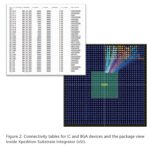The electronic design community is well aware that it faces a daunting challenge to analyze and sign off the next generation of huge multi-die 3D-IC systems. Most of today’s EDA tools require extraordinary resources in specialized computers with terabytes of RAM and hundreds of processors. Customers don’t want to keep buying… Read More
Electronic Design Automation
Webinar – SoC Planning for a Modern, Component-Based Approach
We all know that project planning and tracking are critical for any complex undertaking, especially a complex SoC design project. We also know that IP management is critical for these same kinds of projects – there is lots of IP from many sources being integrated in any SoC these days. If you don’t keep track of what you’re using and… Read More
AI and ML for Sanity Regressions
You probably know the value proposition for using AI and ML (machine learning) in simulation regressions. There are lots of knobs you can tweak on a simulator, all there to help you squeeze more seconds, or minutes out of a run. If you know how to use those options. But often it’s easier to talk to your friendly AE, get a reasonable default… Read More
Ansys Talks About HFSS EM Solver Breakthroughs
Ansys HFSS™ has long enjoyed industry respect as a highly accurate electromagnetic simulator suitable for general purpose applications. Ansys has worked over the years to maintain its gold reference accuracy, and also to dramatically improve its performance and ease of use. A very interesting review of the key technology breakthroughs… Read More
High Reliability Power Management Chip Simulation and Verification for Automotive Electronics
Automotive electronics bring strong demand for power management chips, but its strict reliability requirements also pose new challenges for chip designers. The chip needs to be able to work in various harsh environments such as high temperature, low temperature, aging, abnormal power supply, etc. Although the traditional… Read More
DARPA Toolbox Initiative Boosts Design Productivity
When you think of the Defense Advanced Research Projects Agency (DARPA), this first thing that comes to mind is the development of the internet. And indeed, if you look at their website’s historic timeline, the development of ARPANET, as it was known at the time, is shown prominently in 1969. Incidentally, I actually used one of … Read More
IBM and HPE Keynotes at Synopsys Verification Day
I have attended several past Synopsys verification events which I remember as engineering conference room, all-engineer pitches and debates. Effective but aiming for content rather than polish. This year’s event was different. First it was virtual, like most events these days, which certainly made the whole event feel more… Read More
On-Device Tensilica AI Platform For AI SoCs
During his keynote address at the CadenceLIVE 2021 conference, CEO Lip-Bu Tan made some market trend comments. He observed that most of the data nowadays is generated at the edge but only 20% is processed there. He predicted that by 2030, 80% of data is expected to be processed at the edge. And most of this 80% will be processed on edge… Read More
Heterogeneous Package Design Challenges for ADAS
Increasingly complex heterogeneous packaging solutions have proved essential to meeting the rapidly scaling requirements for automotive electronics. Perhaps there is no better example of this than advanced driver-assistance systems (ADAS) that are found in most new cars. In a recent paper published by Siemens EDA, they … Read More
What the Heck is Collaborative Specification?
It’s been quite a while since I talked with Agnisys CEO and founder Anupam Bakshi, when he described their successful first user group meeting. I reached out to him recently to ask what’s new at Agnisys, and his answer was “collaborative specification.” I told him that I wasn’t quite sure what that term meant, and he offered to spend… Read More












The Quantum Threat: Why Industrial Control Systems Must Be Ready and How PQShield Is Leading the Defense